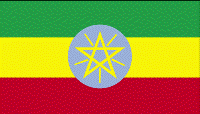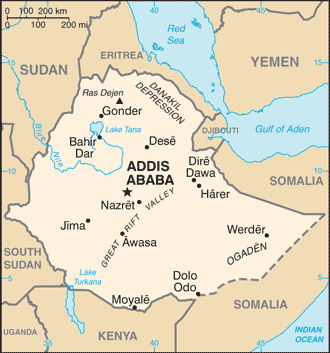Sep 24 2012
Topics Covered
Welcome to Ethiopia
Overview of Resources
Industrial Minerals
Metals
Investment
Sources
Welcome to Ethiopia
Ethiopia, with a total population of 91,195,675 as of July 2012, is located in Eastern Africa, to the west of Somalia. The country mostly has a tropical climate and covers a total area of 1,104,300 km2.
It was only in 1994 that a constitution was adopted in Ethiopia and the country has experienced a number of refugee problems, revolts and wide-scale drought. In 1995, the country had its first multiparty elections.
 |
The national flag of Ethiopia.
Image Credit: CIA Factbook. |
A major portion of Ethiopia’s economy relies on the country’s agricultural sector which accounts for 85% of total employment and 41% of GDP. In 2010, the government introduced a five-year Growth and Transformation Plan that aims to uplift the country’s economic growth rate. Besides this plan, the insurance, banking and micro-credit industries were restricted to only domestic investors even though Ethiopia attracted foreign investments in commercial agriculture, leather, manufacturing and textiles sectors.
Based on these new measures the country managed to maintain a high GDP growth rate, but its per capita income is considered to be one of the lowest in the world. The country’s GDP as of 2011 was $96.09 billion.
Overview of Resources
The key natural resources of Ethiopia include gold, copper and platinum. The country’s chief mineral and mining operations in 2010 included gold, cement, crushed stone and dimension stone production.
In 2010, Ethiopia played a major role in the global production of tantalum that amounted to 11% of the country’s share of global tantalum mine production. In general, Ethiopia was not a significant consumer of minerals globally.
Industrial Minerals
In 2010, Ethiopia had a total of 10 cement plants producing a total output of 3.58 million Mt/yr. Ethiopia’s cement production in 2010 increased to about 2.9 Mt from 2.1 Mt in 2009. In the same year, there was an increase in the domestic demand for cement for the construction of houses, roads and dams.
In 2010, about 1,500 kg of opal was produced at Wegel Tena. Besides opal, the country also produces gemstones that include tourmaline, amethyst, garnet, sapphire, aquamarine, ruby, topaz, peridot and emerald.
Potash was also part of Ethiopia’s chief minerals and in 2010 Allana Resources Inc. of Canada carried out its drilling operations at the Dallol potash deposits.

The map of Ethiopia. Image Credit: CIA Factbook
Metals
Ethiopia is a significant exporter of gold and the country’s largest gold mine is Lega Dembi in the Sidamo province. Midroc Gold, a company that operated Lega Dembi, produced about 3,100 kg/yr of gold. Despite plans of closing this mine in 2013, Midroc Gold further continued to proceed with underground mining at Lega Dembi in order to extend the operations of this mine untill 2021. Through this mine, Midroc Gold planned to produce about 100 kg/yr of gold from 2012 to 2019.
Tantalum is another significant mineral found in Ethiopia. Almost 80% of this mineral is used by Chinese-assembled computers, mobile phones and cameras.
Investment
Ethiopia’s main concern for the future is to increase its exports of industrials minerals and metals. Experts feel that exploitation of Ethiopia’s gold reserves will increase exports and in turn improve the country’s economic growth rate.
The first foreign company to have received the licence to extract gold from western Ethiopia is a British company called Nyota Minerals. The government also hopes to increase the exports of sapphires, diamonds, potash and other industrial minerals and base metals.
By 2015, Ethiopia hopes to see an increase in its production of cement, pumice, gypsum and other construction materials. The government plans to increase the road network to 136,000 km from 49,000 km, build about 500,000 housing units and construct a 2,000-km rail line.
Ethiopia’s economy thus depends exclusively on the increase in exports and more foreign investments, which will help reduce the country’s dependency on imports and boost its mineral and mining sectors.
Disclaimer: The Author of this article does not imply any investment recommendation and some content is speculative in nature. The Author is not affiliated in any way with any companies mentioned and all statistical information is publically available.
Sources